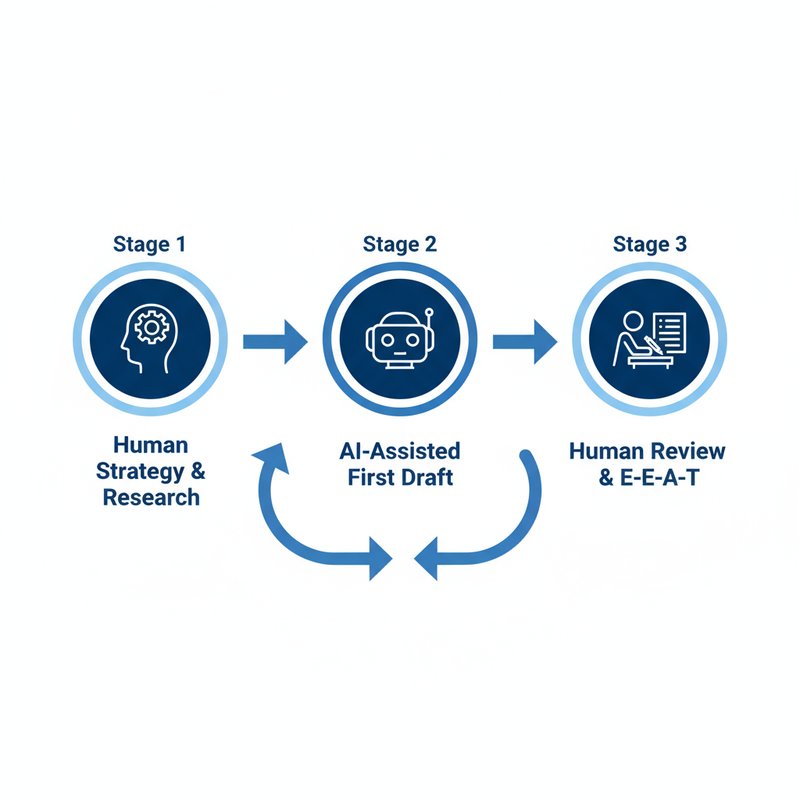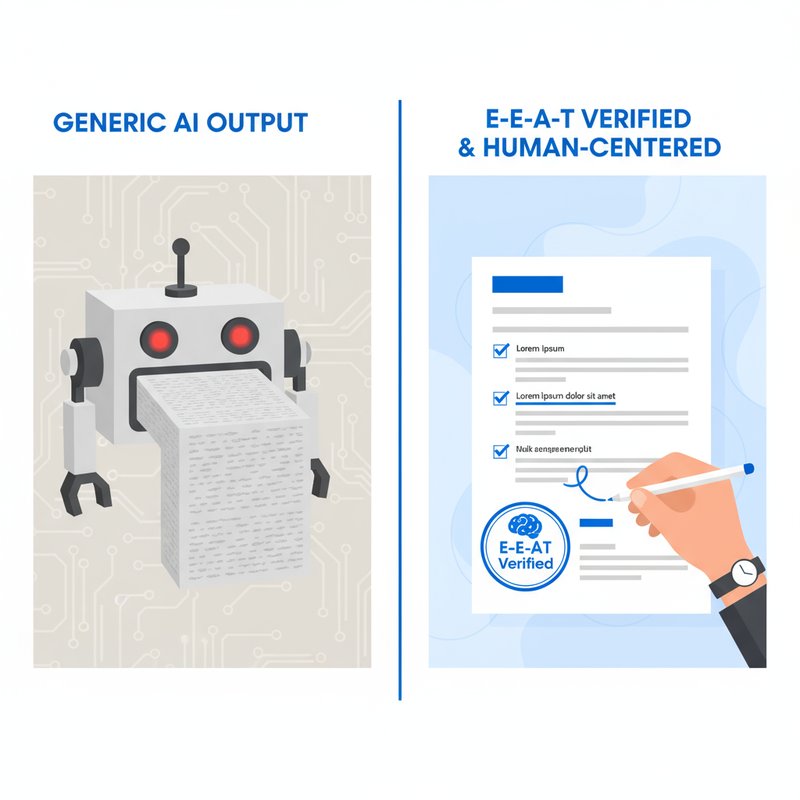Research-Driven AI Content Generator: Rank High-E-E-A-T Content
Frustrated with generic AI content? Learn our research-driven blueprint to use an AI content generator for SEO, create high-E-E-A-T content, & boost rankings. Get your strategy!
The Research-Driven AI Content Blueprint for 2025

The 2025 Research-Driven AI Content Blueprint
Is your AI-generated content failing to rank? You're not alone. According to insights from Harvard on the future of AI in marketing, the strategic implementation of artificial intelligence is rapidly reshaping the digital landscape. In 2025, simply using an AI tool isn't enough. Generic, unverified AI content is the new content farm, and search engines are getting smarter at identifying it. The days of one-click articles that dominate the SERPs are over.
This article moves beyond basic prompting to provide a proprietary, actionable framework for implementing a 'research-driven' AI content workflow. It’s a blueprint for using an AI content generator for SEO not as a magic bullet, but as a powerful assistant guided by human expertise. We will show you how to create high-E-E-A-T content that ranks, builds authority, and avoids the common pitfalls of AI that are holding your strategy back.
Table of Contents
- Why Your Current AI Content Strategy is Failing (And What to Do About It)
- The Research-Driven Framework: Blending AI Efficiency with Human Expertise
- Your Step-by-Step Guide to Creating High-E-E-A-T Content with AI
- Beyond Generation: Using AI for Structured Data and Semantic SEO
- FAQ: Answering Your Top Questions About AI for SEO
- Conclusion
Why Your Current AI Content Strategy is Failing (And What to Do About It)
The promise of instant content was alluring, but many marketers are now facing a harsh reality: the content produced by basic AI generators isn't delivering results. The landscape has shifted, and what worked as a novelty a few years ago is now a liability in 2025. To build a sustainable content strategy, you must first understand why the old "instant" approach is broken.
The Pitfalls of "Instant" AI: Inaccuracy, Genericness, and Google Penalties
The primary issues with relying on out-of-the-box AI tools are what we call the "Three Sins" of automated content: inaccuracy, genericness, and a failure to provide real value. These tools often produce factual errors, "hallucinate" data, and write in a bland, unauthoritative tone. This type of content is precisely what Google’s "helpful content" system is designed to devalue. It lacks original insights, deep analysis, and the first-hand experience that signals true expertise.
According to Google's official guidance on AI content, the focus isn't on how content is produced, but on its quality and helpfulness. The problem is that unguided AI struggles to create content that is truly helpful. While some platforms may claim to offer the best AI content generator, the tool itself is only one part of the equation. Industry leaders like Jasper.ai demonstrate the various SEO tasks their tools can assist with, but achieving genuine success requires a strategic, human-led framework to guide the technology. Without this oversight, even the best AI content generator for blogs can produce content that feels hollow and fails to connect with an audience or rank on search engines.
The Research-Driven Framework: Blending AI Efficiency with Human Expertise

The Human-in-the-Loop AI Content Framework
The solution is to stop thinking of AI as a content creator and start seeing it as a content assistant. The Research-Driven Framework is a "human-in-the-loop" system that puts human strategy and expertise at the forefront, using AI to handle the heavy lifting of drafting. This blend of efficiency and quality is the key to producing high-E-E-A-T content at scale.
Principle 1: Human-Led Research & Strategy
Before a single word is generated by AI, a human expert must lay the strategic foundation. This is the most critical phase, where you define the purpose, angle, and authority of the content. AI cannot replicate strategic thinking, audience empathy, or true competitive analysis. This "research" in "research-driven" is what separates top-ranking content from the noise.
Pre-Generation Research Checklist:
- Keyword & Intent Analysis: What is the primary keyword? What is the user’s search intent (informational, commercial, transactional)?
- Audience Persona Definition: Who are we writing for? What are their pain points and questions?
- Competitive SERP Analysis: Who currently ranks for the target keyword? What angles are they using? What are their content gaps?
- E-E-A-T Sourcing: What authoritative studies, expert quotes, or original data can we incorporate to build trust and authority?
- Unique Angle (UVP): What unique value or perspective will our content offer that competitors do not?
- Strategic Outline: Create a detailed H2/H3 outline that maps the narrative flow of the article. This is the blueprint you will feed the AI.
Learning how to use an AI content generator effectively starts here, long before you open the tool. This human-led strategy is the secret to a powerful AI content generator for SEO workflow.
Principle 2: AI-Assisted First Draft Generation
With a robust, human-created outline and research brief in hand, you can now turn to AI for what it does best: generating a first draft quickly. The key here is not to accept the output as final but to use it as a starting point. Your prompts should be highly detailed, feeding the AI the structure, key points, and research you’ve already gathered.
This approach leverages AI for its efficiency without sacrificing quality control. While some platforms like Content at Scale offer a structured system within their own tool, our tool-agnostic framework emphasizes that the strategic research is the most important element, regardless of which AI content generator for blogs you use. Even a free AI content generator can produce a decent first draft if it is given a high-quality, human-crafted prompt and outline.
Your Step-by-Step Guide to Creating High-E-E-A-T Content with AI
Moving from theory to practice, here is the actionable, step-by-step process for implementing the Research-Driven Framework. This is the "how-to" core of our strategy, designed to produce content that meets the highest standards of quality and SEO performance.
Step 1: The Pre-Brief - Defining Intent, Angle, and Authority
This step operationalizes the human-led research principle. The content brief is the single source of truth for your article, serving as the blueprint for both the AI and the human editor. A comprehensive brief is the foundation of an effective AI content generator for SEO workflow.
Mini Content Brief Template:
- Article Title (Working):
- Primary Keyword & Search Intent:
- Target Audience: (e.g., Intermediate SEO manager frustrated with AI quality)
- Core Article Angle/UVP: (e.g., Move beyond basic prompting to a research-driven framework)
- Mandatory E-E-A-T Sources to Cite: (List URLs of studies, expert quotes, data)
- Competitor Angles to Address/Outperform: (e.g., Outperform Jasper’s tool-specific guide by being framework-focused)
- Detailed Outline: (H1, H2s, H3s with key points and keywords for each section)
Learning how to use an AI content generator properly begins with mastering the art of the brief.
Step 2: Structured Prompting for a High-Quality First Draft
Instead of a simple command like "write a blog post about AI for SEO," your prompts must be structured and detailed. Feed the AI your outline one section at a time, providing context, tone, and specific information to include. As noted in a U.S. Department of Education AI report, providing clear instructions and context is crucial for guiding AI to produce a useful and relevant output.
Example of an Advanced Prompt:
"You are an expert SEO content writer. Write the introduction for a blog post titled 'The Research-Driven AI Content Blueprint for 2025'. Adopt a professional and informative tone. Start by citing a study from Harvard on the future of AI in marketing. Then, introduce the problem that generic AI content is failing to rank in 2025. Finally, introduce the solution: a 'research-driven' AI content workflow. Ensure the keyword 'AI content generator for SEO' is included naturally."
This level of detail is a powerful tool for overcoming AI content generator for writer's block, as it provides a clear direction and structure from the outset.
Step 3: The Human-in-the-Loop - Fact-Checking, Editing, and Adding Experience

Transforming AI Drafts into E-E-A-T Content
This is the most critical step and what truly separates high-E-E-A-T content from generic AI output. The AI-generated first draft is never the final product. A human expert must now refine, fact-check, and enrich the content. The ultimate goal is to align the article with Google's standard of creating helpful, people-first content.
The human editor's role is to:
- Fact-Check Every Claim: Verify all data, statistics, and factual assertions against authoritative sources.
- Add Experience (the "E" in E-E-A-T): Weave in real-world examples, personal anecdotes, case studies, and original insights that an AI cannot generate.
- Refine Tone and Flow: Ensure the writing is engaging, clear, and consistent with the brand voice.
- Check for Originality: Use plagiarism tools to ensure the content is unique and not simply a rephrase of existing articles.
Without this rigorous human-in-the-loop process, even the best AI content generator will produce subpar content.
Beyond Generation: Using AI for Structured Data and Semantic SEO
An advanced AI content generator for SEO strategy extends beyond just writing paragraphs. You can and should use AI to enhance the technical and semantic SEO of your content, helping search engines better understand and feature your work.
Generating Schema Markup and Structured Data with AI
Schema markup is code that helps search engines understand the context of your content, which can lead to rich snippets in the search results. You can use AI to generate this code with simple prompts.
Example Prompt for FAQ Schema:
"Generate JSON-LD FAQ schema markup for the following questions and answers: [Paste your Q&A text here]."
AI-Generated JSON-LD Schema Example:
{
"@context": "https://schema.org",
"@type": "FAQPage",
"mainEntity": [{
"@type": "Question",
"name": "Is using an AI content generator for SEO against Google's guidelines?",
"acceptedAnswer": {
"@type": "Answer",
"text": "No, using an AI content generator is not against Google's guidelines. Google's official stance is that it rewards high-quality content, regardless of how it is produced. The focus is on creating helpful, reliable, people-first content, not on prohibiting AI."
}
}]
}
This is also highly effective for creating How-To, Article, and other types of schema, making it a valuable feature to look for in tools with an AI content generator API.
AI-Powered Internal Linking and Topic Clustering
Building topic authority is crucial for SEO. AI can analyze your entire content library to identify and suggest contextually relevant internal linking opportunities. By prompting an AI with the text of your new article and a list of your existing blog post URLs and topics, you can ask it to suggest natural placements for internal links, strengthening your site’s semantic structure. This is a game-changer for any content manager dealing with a large AI content generator for blogs workflow.
FAQ: Answering Your Top Questions About AI for SEO
Let's address some of the most common questions marketers have about using AI for SEO in 2025.
Is using an AI content generator for SEO against Google's guidelines?
No. As we’ve covered, Google’s guidelines focus on the quality and value of the content, not the method of production. Using AI to produce spammy, low-quality, or unhelpful content is against the guidelines. However, using AI as a tool within a human-led framework to create excellent, people-first content is perfectly acceptable.
Which is the best AI content generator: Jasper, Content at Scale, or others?
The "best" tool is subjective and depends on your workflow. However, the more important question is about your framework. As publications like Search Engine Journal have explored, the landscape is full of options. Some users may search for AI content generator vs Jasper looking for a clear winner. The reality is that the most successful content teams are not defined by their specific tool, but by their research-driven process. The framework outlined in this article can be applied to any high-quality generator to produce superior results.
How can I use an AI content generator to overcome writer's block?
This is one of the best use cases for AI. By feeding a generator your research and a detailed outline, you can get a structured first draft to work from. This solves the "blank page" problem and allows you to focus on the higher-value tasks of editing, adding experience, and refining the narrative. It turns an AI content generator for writer's block into a powerful brainstorming and drafting partner.
What is the pricing for typical AI content generators?
AI content generator pricing varies widely. Some tools offer a "freemium" model with limited free credits. Most operate on a subscription basis, with costs ranging from around $50/month for individual plans to several hundred or thousands of dollars for enterprise-level access and API usage. Pricing is often tiered based on the number of words generated, the number of user seats, and access to advanced features.
Conclusion
In 2025, the conversation around AI in content marketing has matured. The competitive advantage no longer comes from simply using AI, but from how you use it. One-click generation and unverified outputs are a fast track to irrelevance. The future of high-ranking content lies in a sophisticated, human-in-the-loop system.
The Research-Driven Framework provides the blueprint for this future. By blending human-led strategy, research, and expertise with the powerful efficiency of AI-assisted drafting, you can create a scalable process for producing high-quality, high-E-E-A-T content. This is how you win at SEO now and in the years to come.
Ready to move beyond generic content? Book a strategy call to see how our research-driven AI process can transform your SEO results.